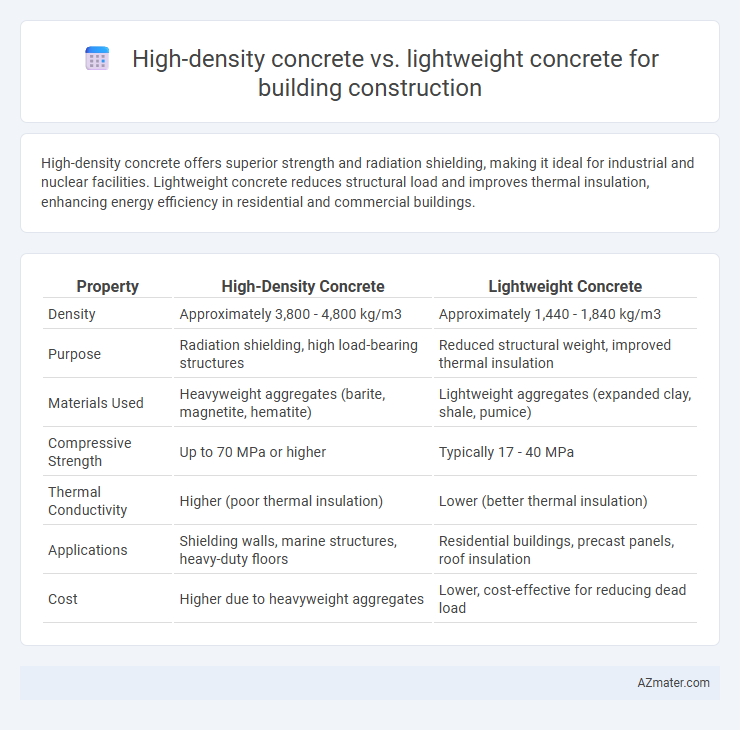High-density concrete offers superior strength and radiation shielding, making it ideal for industrial and nuclear facilities. Lightweight concrete reduces structural load and improves thermal insulation, enhancing energy efficiency in residential and commercial buildings.
Table of Comparison
| Property | High-Density Concrete | Lightweight Concrete |
|---|---|---|
| Density | Approximately 3,800 - 4,800 kg/m3 | Approximately 1,440 - 1,840 kg/m3 |
| Purpose | Radiation shielding, high load-bearing structures | Reduced structural weight, improved thermal insulation |
| Materials Used | Heavyweight aggregates (barite, magnetite, hematite) | Lightweight aggregates (expanded clay, shale, pumice) |
| Compressive Strength | Up to 70 MPa or higher | Typically 17 - 40 MPa |
| Thermal Conductivity | Higher (poor thermal insulation) | Lower (better thermal insulation) |
| Applications | Shielding walls, marine structures, heavy-duty floors | Residential buildings, precast panels, roof insulation |
| Cost | Higher due to heavyweight aggregates | Lower, cost-effective for reducing dead load |
Introduction to High-Density and Lightweight Concrete
High-density concrete typically contains barite, magnetite, or hematite aggregates, resulting in densities above 3000 kg/m3, making it ideal for radiation shielding and vibration damping in building construction. Lightweight concrete incorporates lightweight aggregates such as expanded clay, shale, or pumice, reducing density to 1600-2000 kg/m3, which improves thermal insulation and reduces structural load. Both types offer specialized advantages, with high-density concrete enhancing structural durability and lightweight concrete optimizing energy efficiency and handling.
Composition Differences: High-Density vs Lightweight Concrete
High-density concrete typically consists of heavyweight aggregates such as barite, magnetite, or hematite, resulting in a density exceeding 3,000 kg/m3, while lightweight concrete incorporates low-density aggregates like expanded clay, shale, or pumice, with densities ranging between 1,200 and 1,800 kg/m3. The mix design of high-density concrete emphasizes minimizing voids and maximizing aggregate packing to achieve enhanced radiation shielding and structural mass, whereas lightweight concrete prioritizes air entrainment and porous aggregates to reduce thermal conductivity and overall building load. These compositional distinctions directly impact mechanical properties, durability, and application suitability in building construction.
Key Physical Properties Comparison
High-density concrete exhibits a density range typically between 2400 to 4000 kg/m3, providing superior compressive strength and radiation shielding properties, making it ideal for specialized construction such as nuclear facilities and heavy structures. Lightweight concrete, with a density ranging from 1400 to 1800 kg/m3, offers enhanced thermal insulation and reduced dead load, facilitating easier handling and better seismic performance in residential and commercial buildings. The thermal conductivity of high-density concrete is generally higher, whereas lightweight concrete demonstrates improved fire resistance and sound absorption due to its porous aggregate composition.
Strength and Structural Performance
High-density concrete offers superior compressive strength and enhanced radiation shielding, making it ideal for structures requiring high load-bearing capacity and durability. Lightweight concrete provides adequate strength with reduced self-weight, improving seismic resistance and ease of handling in construction. Structural performance depends on project-specific demands, where high-density concrete excels in heavy-load applications and lightweight concrete benefits designs prioritizing weight savings and energy efficiency.
Thermal Insulation Capabilities
High-density concrete offers superior structural strength but has lower thermal insulation capabilities compared to lightweight concrete, which contains air pockets that significantly reduce heat transfer. Lightweight concrete's improved thermal insulation enhances energy efficiency in building construction by maintaining consistent indoor temperatures and reducing heating and cooling costs. Choosing lightweight concrete is advantageous in climates requiring enhanced thermal performance, whereas high-density concrete suits applications prioritizing strength over insulation.
Durability and Longevity in Construction
High-density concrete exhibits superior durability and longevity in construction due to its enhanced compressive strength and resistance to abrasion, impact, and harsh environmental conditions. Lightweight concrete offers benefits in reducing structural load and improving thermal insulation but generally has lower density and compressive strength, which may affect long-term durability under heavy load or aggressive exposure. For projects requiring maximum durability and longevity, high-density concrete is often preferred because of its resistance to weathering, chemical attacks, and reduced permeability.
Applications in Modern Building Projects
High-density concrete is ideal for radiation shielding, soundproofing, and structures requiring high durability, commonly used in hospitals, nuclear plants, and heavy-duty marine constructions. Lightweight concrete offers benefits in reducing structural load, enhancing thermal insulation, and improving fire resistance, making it suitable for high-rise buildings, precast panels, and insulating roof slabs. Modern building projects leverage high-density concrete for specialized applications requiring strength and protection, while lightweight concrete is favored for sustainable design and energy efficiency.
Cost Considerations and Economic Impact
High-density concrete typically incurs higher material and transportation costs due to its use of heavy aggregates like barite and magnetite, making it more expensive than lightweight concrete, which utilizes lightweight aggregates such as expanded clay or shale. Lightweight concrete offers economic advantages by reducing structural dead loads, leading to savings in foundation and structural steel costs, and often lowers overall construction expenses. Cost considerations highlight lightweight concrete's efficiency in minimizing indirect expenses, whereas high-density concrete is favored for specialized applications requiring radiation shielding despite its greater initial investment.
Environmental and Sustainability Factors
High-density concrete, with its increased mass and thermal inertia, offers enhanced radiation shielding and durability but consumes more energy and natural resources during production, resulting in a higher carbon footprint compared to lightweight concrete. Lightweight concrete, often made with recycled aggregates such as expanded clay or fly ash, reduces the structural load and improves insulation, thereby lowering energy demand in buildings and promoting sustainability. Choosing lightweight concrete supports environmental goals by minimizing raw material extraction and enhancing energy efficiency throughout a building's lifecycle.
Choosing the Right Concrete for Your Project
High-density concrete offers superior radiation shielding and structural strength, making it ideal for specialized projects like nuclear plants and heavy infrastructure. Lightweight concrete reduces dead load, enhances thermal insulation, and improves fire resistance, benefiting residential and commercial buildings where weight savings are crucial. Selecting the right concrete depends on project requirements such as load-bearing capacity, environmental conditions, and specific performance needs.

Infographic: High-density concrete vs Lightweight concrete for Building construction
 azmater.com
azmater.com